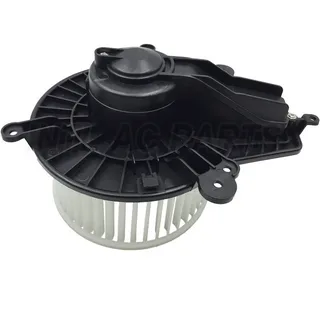The fan blower motor plays a crucial role in keeping your Suzuki Swift comfortable and enjoyable. This unsung hero of your vehicle’s climate control system ensures that you stay cool in the summer and warm in the winter. But what happens when this essential component starts acting up? Whether it’s strange noises, weak airflow, or complete failure to operate, dealing with Swift Fan Blower Motor issues can be frustrating.
Understanding The Role of the Fan Blower Motor
The fan blower motor is vital to your Suzuki Swift’s heating and cooling system. Its primary role is circulating air throughout the cabin, ensuring you remain comfortable regardless of external temperatures. When you adjust the climate control settings, this little workhorse kicks into gear.
Typically located behind the dashboard or in the engine compartment, the motor draws in outside air or recirculates interior air through the vehicle’s ventilation system. It works alongside other systems, such as the heater core and evaporator, to provide optimal temperature regulation.
When functioning correctly, you’ll notice smooth airflow from vents while driving. This can significantly enhance your overall driving experience by providing comfort during long journeys or extreme weather conditions.
However, when issues arise with your fan blower motor, you may find yourself dealing with inconsistent airflow or even total failure to operate altogether. Recognizing its importance helps underscore why regular maintenance of this component should be part of your vehicle care routine.
Understanding how essential this small but mighty motor is will help drivers appreciate its function and recognise when something isn’t quite right with their Swift’s climate control system.
Common Symptoms of Fan Blower Motor Issues
Several symptoms can emerge when your Suzuki Swift’s fan blower motor starts to fail. One of the most noticeable signs is a lack of airflow from the vents. You may turn up the fan speed, but nothing seems to happen. This could indicate that the motor is struggling or has completely stopped working.
Another common symptom is unusual noises coming from the dashboard area. If you hear grinding, rattling, or whirring sounds when you activate the fan, it might indicate that something is amiss with the motor or its components. Ignoring these sounds can lead to further damage.
You might also notice fluctuating speeds while driving. If your fan speeds vary unpredictably—switching between high and low—it suggests there could be electrical issues at play affecting how power reaches the blower motor.
An unpleasant odour can sometimes accompany these problems, too. A burnt smell may indicate overheating components or wiring issues within your heating and cooling system.
If there’s no heat in winter months’ despite setting your temperature settings correctly, that’s another clear sign of potential trouble with your Swift’s fan blower motor. Addressing these symptoms early on will help maintain comfort during your drives.
Tools and Equipment Needed for Suzuki Swift Blower Motor
The right tools are crucial for effectively diagnosing Suzuki Swift Blower Motor issues. First up is a multimeter. This handy device measures voltage, current, and resistance. With it, you can check for electrical faults affecting your motor.
Next on the list are basic hand tools like screwdrivers and wrenches. These will help you access various parts of your vehicle easily. A socket set may also come in handy for removing screws or bolts securing components around the fan blower.
Remember about a test light as well! It’s essential for confirming the power supply to different connections within the system. If no power reaches the motor, that could indicate a bigger electrical issue.
Another useful tool is a vacuum gauge if you’re suspecting airflow problems related to your fan blower setup. This simple instrument can provide insight into whether restrictions exist in ductwork or filters.
Protective gear should be included in your toolkit—gloves and safety glasses ensure your safety while working under the dashboard or near electrical systems. These tools make diagnosing issues with your Swift’s fan blower motor much more manageable.
Diagnosing Electrical Problems
Diagnosing electrical problems in your Swift fan blower motor can seem daunting, but breaking it down into manageable steps makes the process easier. Start by checking the fuse related to the blower motor. A blown fuse could be the simplest fix you need.
Next, inspect the wiring harness for signs of wear or damage. Look for frayed wires or loose connections that might disrupt power flow. If you find issues, repair or replace these components before proceeding.
A multimeter is used to test the voltage at the blower motor connector. Switch on your vehicle and set your multimeter to measure DC voltage. If no reading is obtained, this indicates an upstream electrical issue requiring further investigation.
Additionally, verify if there’s a ground connection problem by checking the continuity between the blower motor housing and the battery negative terminal. Lack of proper grounding may cause intermittent operation or complete failure.
If everything else checks out fine, consider potential control module faults. Sometimes, electronic controls misbehave due to software glitches or internal failures, affecting how power is directed to your fan blower motor system.
Testing The Rodeo Fan Blower Motor
Testing the Rodeo Fan Blower Motor is crucial to identifying any issues. First, ensure that the vehicle is turned off and parked safely. Disconnect the battery as a precautionary measure before proceeding.
Next, locate the fan blower motor under the dashboard on the passenger side. Remove any necessary panels or covers for better access. Once you have clear visibility of the motor, check for visible signs of damage or wear. Look closely at wiring connections; they should be secure and corrosion-free.
Using a multimeter set to voltage mode, connect one probe to each terminal on the blower motor connector while turning on your ignition switch without starting the engine. If everything is functioning correctly, you should read around 12 volts.
If there’s no voltage present, it may indicate an electrical issue upstream—perhaps a blown fuse or faulty relay needs attention first. Conversely, if you detect proper voltage but hear no sound when activating the fan switch, this suggests that your blower motor itself might be faulty and require replacement.
After testing voltages and confirming connectivity issues do not exist elsewhere in your system, moving forward with repairs becomes more straightforward.
Resolving Common Issues
Resolving the Swift fan blower motor issues often involves a few straightforward steps. Start by checking the fuse linked to the blower motor. A blown fuse can easily reduce power and prevent your system from functioning.
If the fuse is intact, inspect the wiring for any signs of corrosion or damage. Loose connections can lead to intermittent performance. Tightening or replacing damaged connectors may restore normal operation.
In some cases, debris might accumulate around the blower motor or inside its housing. Cleaning these areas ensures optimal airflow and prevents overheating, which can ultimately prolong your blower’s lifespan.
If you suspect a faulty resistor module, it’s essential to replace it promptly. This component regulates speed settings; if it’s malfunctioning, your fan’s operation at different levels will be erratic.
Consider lubricating moving parts if noise is an issue during operation. Sometimes, all it takes is a little maintenance to keep everything running smoothly again without needing extensive repairs on your Swift fan blower motor.
Reassembling and Testing the System
Reassembling After Fixing the Swift Fan Blower Motor
Once you’ve resolved the issues with your Swift fan blower motor, it’s time to reassemble everything. Start by carefully returning any components you removed during the diagnosis. Ensure that all connectors and clips are securely fastened to prevent future problems.
Reconnecting Electrical Wiring
Pay extra attention when reconnecting the electrical wiring. Each connection must be tight and free from corrosion or damage. Double-check for any loose wires that could cause intermittent failures in the future.
Replacing Covers and Casings
Next, replace any covers or casings you removed to access the motor. Ensure that they fit snugly without forcing them into place to avoid rattling sounds while driving.
Testing the Fan Blower Motor
After reassembly, power up your Suzuki Swift and test the fan blower motor’s functionality. Turn on the ignition and adjust the speed and direction settings. Listen for any unusual noises that might indicate a lingering issue.
Preventive Maintenance Tips of Rodeo Heater Fan
Regular preventive maintenance can significantly extend the life of your Rodeo Heater Fan. Start by inspecting the cabin air filter every few months. A clogged filter restricts airflow and puts extra strain on the engine, leading to potential failures.
Another essential tip is to keep an ear out for unusual noises from the blower. Squeaks or rattles may indicate debris trapped in the system or worn components that need attention. Addressing these issues early can save you time and money later.
Cleaning around the blower motor itself is also crucial. Dust and dirt buildup can impede performance, so it is a habit to wipe off any grime occasionally. This small step keeps airflow optimal.
Conclusion
Understanding your Suzuki Swift’s fan blower motor is essential for a comfortable driving experience. These motors regulate cabin temperature and air circulation, directly impacting passenger comfort.
Addressing issues with the Swift fan blower motor can prevent larger problems. Regular maintenance keeps your vehicle running smoothly and enhances its longevity. Awareness of common symptoms will help you diagnose issues before they escalate.
The tools and techniques covered can empower you to handle minor repairs confidently. With some basic knowledge, diagnosing electrical faults or testing the motor becomes manageable tasks that save time and money.
Remember that every vehicle requires attention over time. By monitoring your fan blower motor’s performance, you’re taking proactive steps toward better vehicle care.
Preventive maintenance ensures the lasting functionality and efficiency of your car’s systems. This approach minimizes unexpected breakdowns, allowing for more enjoyable journeys in your Suzuki Swift.
FAQs
What does the fan blower motor do in my Suzuki Swift?
The fan blower motor circulates air through the vehicle’s cabin. It helps control temperature and airflow, ensuring comfort for all passengers.
Can I repair a faulty fan blower motor myself?
Yes! With basic tools and knowledge of your vehicle’s electrical system, diagnosing and sometimes fixing minor issues can be manageable for an enthusiastic DIYer.
What tools will I need for diagnosis?
To access the fan blower assembly, you’ll typically need a multimeter to test electrical connections and basic hand tools like screwdrivers and pliers.
How often should I perform maintenance on my heater system?
It is advisable to perform regular checks during routine car service appointments. Observing any irregularities early on can prevent major repairs later.
| Related Business Listings |
| Contact Directory |
| Local Business Profiles |




